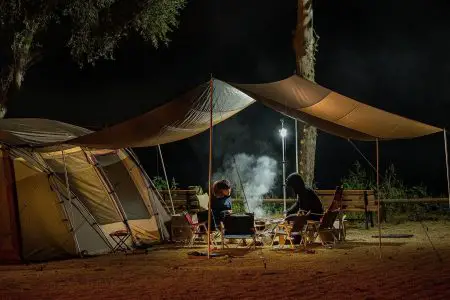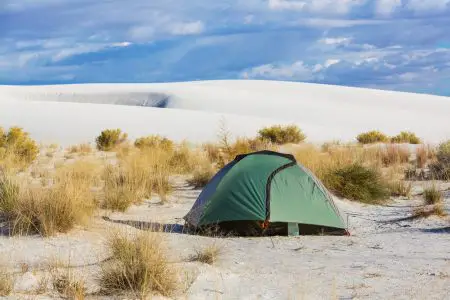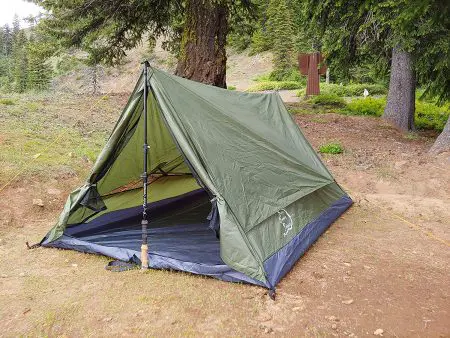Bug Out Tents
Bug out tents aren’t on everyone’s list of things that you need in a bug out bag. Why is that? It seems like having a tent in your bug out bag would be a good idea, but is it?
A bug out tent is usually a small one-person tent that is lightweight and can be carried inside your bug out bag to give you shelter while you’re bugging out. They can also be a tent that you can set up once you get to your bug out location to act as shelter or an expanded living area.
Should you consider buying a bug out tent? Keep reading to find out.
[wc_toggle title=“Table of Contents” padding=“” border_width=“” class=“” layout=“box”]
[/wc_toggle]
[wc_box color=“inverse” text_align=“left” margin_top=“” margin_bottom=“” class=“”]
Thanks for supporting Ready Lifestyle! We participate in the Amazon associates program and other affiliate programs. We earn a small commission on qualifying orders at no expense to you.
Why Would You Want a Bug Out Tent
In my mind, there are two reasons that you’d want to have a bug out tent. One is straight forward and the other may be overlooked by most people.
The first reason to have a bug out tent is pretty obvious. You could be forced to bug out during a time of the year where you need to protect yourself from the environment.
During seasons with extremes like cold temperatures or frequent rainy weather, it makes sense to have a bug out tent available.
The second reason to have a tent is as an addition to your bug out location. You can use it as shelter once you get there or as an extension of your living area.
[wc_box color=“primary” text_align=“left” margin_top=“” margin_bottom=“” class=“”]
Tents follow all of the basic shelter building principals that makeshift shelters do. Make sure that you understand them!
[/wc_box]
Do you need a bug out tent?
If you live in an area that experiences very cold weather or long rainy seasons then I’d suggest adding a tent to your bug out bag. I usually don’t recommend a tent because you should really be moving to your bug out location pretty quickly and building a tent just adds weight to your bug out bag in most situations and really isn’t needed.
Another reason to have a bug out tent is if you plan to bug out to an area that doesn’t have any pre-build shelter or if you’re not really sure where you may end up bugging out to.
I also think a good use of a bug out tent is to add living area to your bug out location. In this scenario, you would take a pop-up carport or gazebo to supplement a small permanent structure like a hunting or fishing cabin.
You can pack this larger tent in your car or truck and use it as an area to set up an outside cooking or eating area. This lets you use the permanent structure for more important things like sleeping areas.
What to Look for in a Bug Out Tent
There are certain things that make a tent better for bugging out over other tents. Price, weight, size, color, material, and its level of water resistance are all important.
Price
Price is important if you’re on a budget. The good thing is there are usually plenty of products that function well at lower price points, and tents are no different.
Weight
Modern tents, made with modern materials actually weigh very little compared to how large they are. I would try to keep the weight down as much as possible without losing a lot of functionality from the tent. Keep it under 3 pounds if you can.
If you go for something like an emergency shelter then you can get the weight down to about ½ lb, but these tents aren’t great for keeping the elements out. I would rather just not bring a tent in most circumstances.
If you plan on packing a larger tent in a vehicle then the weight doesn’t really matter much. Just make sure it’s light enough that you can get it out of the car easily and set it up with one or two people.
Size
The biggest drawback of bringing a tent with you is the amount of space that it takes up in a bug out bag. I’m a fan of tents that don’t need poles and can be set up with sticks or tied to trees. This style of tent really cuts down on the amount of space needed in a backpack and usually are less than a foot long and 6 inches wide when they’re packed up!
Again, the super small emergency tents seem like they would be great because of their small size, but I don’t really find them useful in a scenario where I’m planning to use a tent.
For tents that are going to go into a car, you don’t need to worry too much about the size, but there is a point that it can be too large. It the tent you’re planning on taking start to displace things like food and water from your loadout you’re probably going to want to look for something a little smaller if you can.
Color
Color is important because you want to be able to blend into the environment if you need to. Usually, this won’t be a problem, but there are definitely occasions where I could see not wanting to be seen while you’re bugging out.
Choose colors that are close to the environment you’re most likely to bug out in. If you can’t find an exact match, I wouldn’t worry about it.
If you really need to blend in then you can use brush and vegetation from the surrounding area to help your tent blend in. If there isn’t much brush and other things to help you blend in, then your tent is probably going to stick out like a sore thumb no matter what color it is.
Material
Pretty much any tent that you’re going to get these days is going to be made of nylon or some other synthetic material. These materials are light and help prevent water from penetrating them.
The main way that material affects the tent is through durability. Look for strong tents that aren’t going to tear easily but are still light enough to make carrying them easy.
Water Resistance
Any tent that you get should be mostly waterproof. You can seal a new tent if you’re worried about water getting in or if you plan on using it in extremely wet weather.
Tents that have an additional rainfly are going to be heavier, but they usually stay dry for longer. If you plan on bugging out in a rainy season, go for a tent with a rainfly and don’t worry about the minor added weight.
Bug Out Shelters That Aren’t Tents
Tents aren’t the only type of shelter that makes sense for bugging out. There are actually quite a few options that may be even better than tents.
Tarps
Tarps are a multi-use piece of equipment that can fill a whole range of roles. One of those roles is as a makeshift shelter.
If you know that you’re going to need a tent, then buy a tent. If you’re not sure, or you only need a tent for a couple of months out of the year, then a good quality tarp could make sense.
Tarps are easy to use to make into a bunch of different shelters. Make sure that you pack some 550 cord and tent stakes to make building a shelter a little easier on you.
Hammocks
Hammocks don’t usually come to mind right away when we’re thinking about shelters but they actually do several things that make them great.
Hammocks naturally lift you off of the ground which prevents you from losing a lot of body heat into the ground. You still have the wind that can suck body heat away but if you put a decent underquilt under the hammock you’ll stop that from happening.
You can also set up a tart over the top of your hammock to prevent rain or snow from getting you wet while you sleep. Just make sure that it covers enough of your hammock so it completely blocks the rain and doesn’t drain onto you as the rain runs off.
The big drawback of hammocks is that you need to be able to attach both sides to a tree, pole, building, car or something else when you set them up. If you’re traveling across flat land you could have a hard time setting up a hammock.
Bivy Sacks
Bivy sacks are another great option if you’re trying to keep your gear lightweight and compact. They’re basically a waterproof shell that you can slide your sleeping bag into.
I prefer to use bivy sacks that have added headroom and zip completely closed to protect you from the elements. Look for a GoreTex bivy sack that zips completely closed for the best results.
Best Bug Out Tents
These two tents are some of my favorites in the ultralight backpacking tent realm that won’t break the bank.
Be sure to wear warm clothing and/or pack a sleeping bag if you need to stay warm. These tents are great for keeping you out of the wind and keeping the rain off of you, but they’re not going to arm enough in low temperatures.
River Country Products Trekker Tent 1.2
The Trekker Tent 1.2 is an ultralight one-person tent that doesn’t come with any poles. It’s designed to be held up with trekking poles so it keeps the weight down. The good thing is that any sturdy branch can also hold it up.
The .2 version has been redesigned to better seal the seams and the tent as a whole so it’s more resistant to the elements. Get the .2 version since it’s basically the same price and provides more protection.
- Inside Dimensions: 7′ long, 48” wide, and 42” tall in the front and 32” in the back
- Weight: 2 lbs 8 oz.
River Country Products Trekker Tent 2.2
The Trekker Tent 2.2 is super compact and designed for 2 people. Just like the 1.2 it’s meant to be held up with trekking poles, but you can use just about anything to keep it propped up.
Get the .2 version of the tent because they made it more resistant to water by beefing up the seams and sealing the whole thing better.
- Inside Dimensions: 7’ long, 62" wide, and 42" tall
- Weight: 3 lbs.
Larger Tents
For larger tents, I like simple, easy to set up options that don’t take up a lot of room when they’re packed up. Most large 10’ x 10’ or larger tents are between 50 and 100 lbs. so having a carrying case with wheels is another plus.
What to look for in larger tents:
- Packs small enough to fit in the vehicle you plan to bug out in.
- Easy to assemble with 2 people and able to be assembled with 1 person if needed.
- Packs into a case that has wheels to allow you to move it around as needed.
Conclusion
Bug out tents are great if you’re going to be bugging out in inclement weather or if you need to set up some kind of shelter at your bug out location. They’re also a necessity if you don’t have a predetermined bug out location selected.
Look for small, compact and lightweight tents for your bug out bag itself, and sturdy, easy to assemble tents to add to your bug out vehicle.
Bug Out Tents: Are They Right for You? was first published on: Ready Lifestyle
Bug Out Tents: Are They Right for You? published first on https://readylifesytle.tumblr.com




Comments
Post a Comment